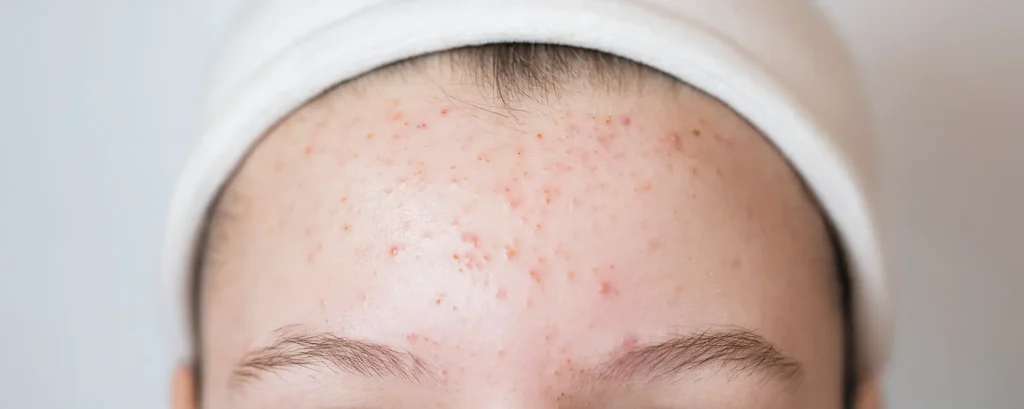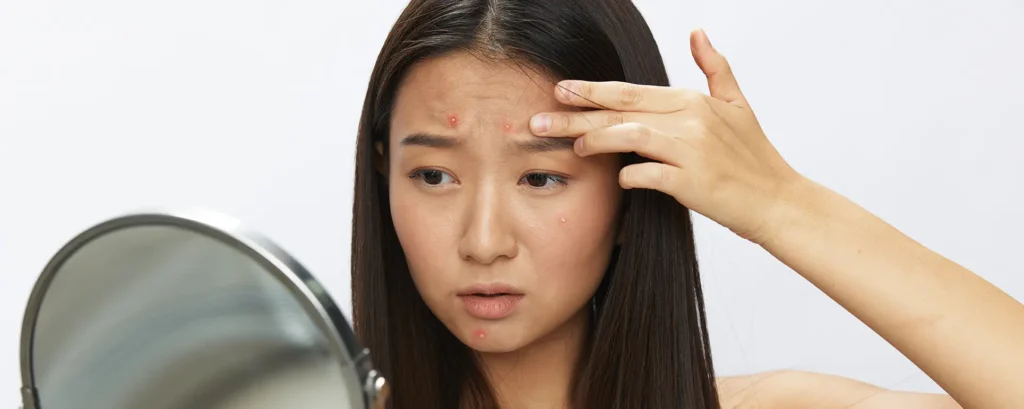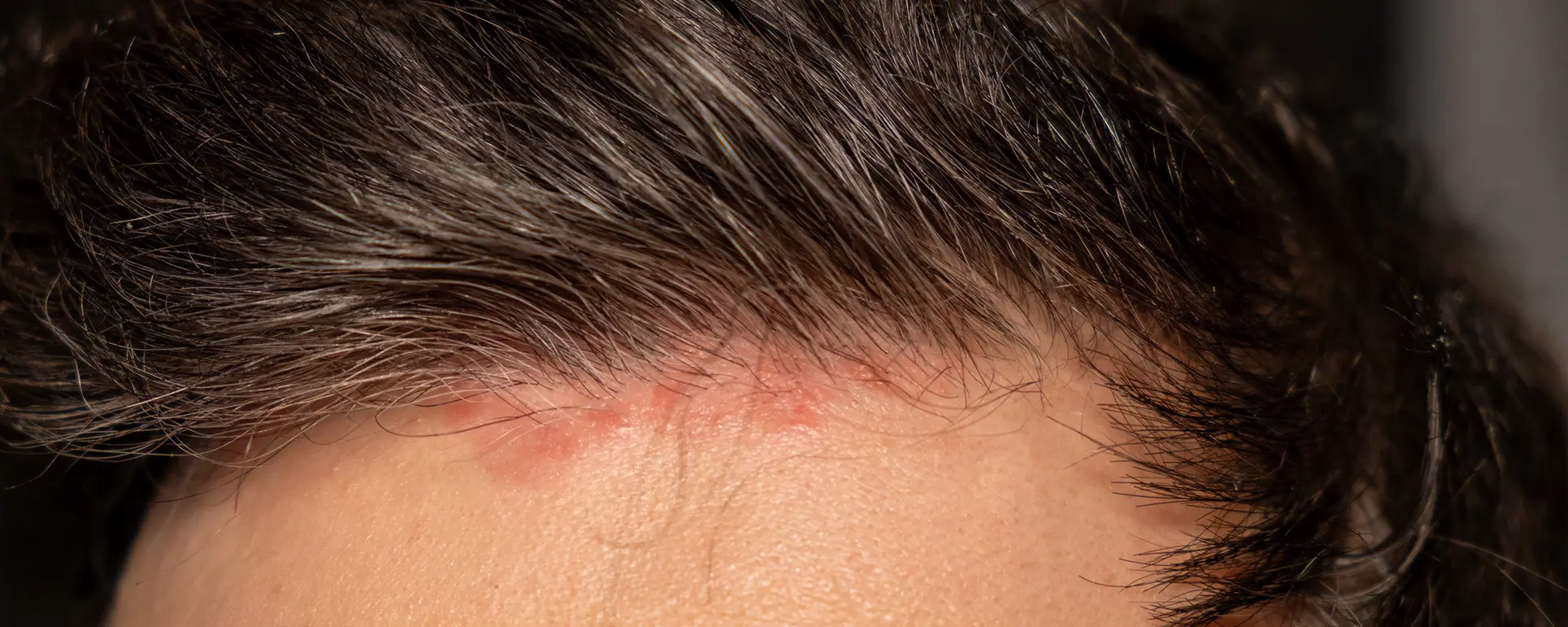Acne isn’t always caused by diet, hormones, or genetics, even though these are often the first factors people think of when their skin starts breaking out. Surprisingly, sometimes the very products you use every day to keep your hair clean and healthy such as shampoos, conditioners, hair masks, and styling products can contribute to the problem. These products may leave residues on your hair and scalp, which can transfer to your skin, particularly along the hairline, forehead, temples, and even the back. Over time, this buildup can clog pores, trigger inflammation, and lead to breakouts, even if you follow a consistent skincare routine.
The connection between hair care products and acne isn’t always obvious. Many people focus solely on their face creams, cleansers, and serums, assuming that if these are carefully chosen, their skin should remain clear. However, the skin on your forehead, temples, and neck comes into direct contact with hair, and any lingering oils, silicones, or heavy conditioning agents from hair products can seep into pores and provoke irritation. This type of acne is sometimes referred to as “pomade acne” or “hairline acne,” and it can be especially frustrating because it seems to appear in the areas you wouldn’t normally expect.
Understanding how and why hair care products contribute to breakouts is the first step in preventing them. Not all shampoos or conditioners are created equal some formulas contain ingredients that are more likely to irritate the skin or clog pores. In addition, habits like applying conditioner too close to the scalp, not rinsing thoroughly, or letting hair rest against the face while sleeping can all exacerbate the problem. By becoming aware of these triggers and learning how to adjust your hair care routine, you can protect your skin while still keeping your hair healthy and nourished.
In this article, we’ll explore the link between shampoos and acne, identify the ingredients and habits most likely to cause breakouts, and share practical tips for maintaining clear skin without sacrificing your hair care regimen. With a little insight and some small changes, it’s possible to enjoy both healthy hair and a blemish-free complexion.
How Shampoo and Hair Products Can Trigger Acne

Ingredients That Irritate Skin
Not all hair care products are created equally, and some contain ingredients that can unexpectedly irritate your skin. Heavy oils, silicones, sulfates, and certain synthetic fragrances are among the most common culprits. While these ingredients can leave your hair feeling silky, smooth, or nourished, they can also leave behind a residue along the hairline, forehead, temples, neck, and behind the ears. Over time, this buildup can trap sweat, dirt, and bacteria against the skin, creating an ideal environment for acne to form.
Even products marketed as “gentle,” “suitable for sensitive skin,” or “non-drying” can contribute to breakouts in some people. Coconut oil, lanolin, mineral oils, and certain silicones may clog pores, especially in individuals with naturally oily or combination skin. On the other hand, sulfates common in many shampoos can strip the scalp and hair of natural oils, prompting the skin to overproduce sebum in response. This excess oil can settle along the hairline, leading to inflamed pores, redness, and small pimples.
It’s also worth noting that some hair care products include alcohols, preservatives, or synthetic fragrances, which can irritate sensitive skin and worsen acne. The reaction may not be immediate; sometimes, breakouts appear hours or even a day after using the product. Learning to read ingredient labels carefully and observing how your skin reacts to different formulas can be the key to maintaining both healthy hair and clear skin.
Pomade Acne
Pomade acne is a specific type of breakout that occurs when styling products come into contact with your skin. This is most commonly seen along the forehead, temples, and hairline, but it can extend to the nape of the neck in some cases. While the term “pomade acne” originates from traditional waxy or greasy hair products, the condition can also be triggered by leave-in conditioners, hair serums, styling creams, and even lightweight oils.
These products often contain oils, waxes, or silicones that block pores, trap dirt, and create an environment conducive to bacterial growth. The result is small, inflamed bumps or pimples that may be stubborn to treat with standard facial skincare alone. Pomade acne is particularly common in people with longer hair that rests against the face throughout the day or night, those who use heavy styling products frequently, or anyone who applies leave-in products directly at the roots.
One challenge with pomade acne is that it often mimics regular acne, which can make it difficult to identify without examining your hair care habits. Treating it as regular acne without adjusting your hair routine may provide only temporary relief. Awareness of the condition allows you to take preventive measures, such as limiting product application near the hairline, washing hair before bed, or switching to lighter, non-comedogenic hair products.
Back and Shoulder Breakouts
Acne caused by hair products doesn’t only appear on the face it can also affect the upper back, shoulders, and occasionally the upper chest. When shampoo, conditioner, or other hair treatments run down your back during showering, they can mix with sweat, natural oils, and bacteria on the skin. This combination can irritate pores and lead to breakouts.
Individuals who use thick conditioning treatments, deep masks, or leave-in products are more prone to this type of acne. Even after thorough rinsing, residues may remain on the skin, particularly in areas where hair naturally rests against the back and shoulders. Over time, this can result in clusters of small, inflamed bumps, redness, or even cystic acne in more severe cases.
Preventing back and shoulder breakouts involves a combination of proper rinsing techniques, choosing lighter or non-comedogenic hair care products, and incorporating gentle exfoliation into your routine. Showering immediately after sweating and ensuring hair products are fully rinsed away can also make a significant difference. These small adjustments can dramatically reduce the likelihood of breakouts while still allowing you to care for your hair effectively.
Understanding the Connection Between Hair and Skin
Many people don’t realise just how closely connected hair care and skin health are. The skin along the hairline, forehead, neck, back, and shoulders is constantly exposed to hair products, oils, and environmental debris. Over time, repeated contact with pore-clogging ingredients can contribute to ongoing acne issues. By recognising the connection, you can take steps to adjust your hair care routine, select products wisely, and protect your skin without sacrificing the health and appearance of your hair.
Tips to Prevent Shampoo-Related Acne

Choose Non-Comedogenic Hair Products
Not all shampoos, conditioners, and styling products are suitable for acne-prone skin. Ingredients like heavy oils, silicones, and certain waxes can clog pores and contribute to breakouts, particularly along the hairline, forehead, and neck. Look for hair care products specifically labelled as “non-comedogenic” or “safe for acne-prone skin.” These formulas are designed to nourish and protect your hair without leaving residues that irritate the skin. Even products marketed as gentle or moisturising can sometimes trigger acne, so paying attention to ingredient lists is key. Avoid products with a high concentration of fragrances, mineral oils, or alcohols, as these can dry or inflame sensitive skin. Switching to lightweight, non-comedogenic products can significantly reduce the risk of hair-product-related breakouts over time.
Rinse Thoroughly
Proper rinsing is one of the simplest yet most effective ways to prevent acne caused by hair products. Leftover shampoo, conditioner, or hair masks can accumulate along the hairline, scalp, and nape of the neck, mixing with sweat and sebum to clog pores. Make it a habit to rinse your hair thoroughly, taking extra care to ensure that no residue remains behind the ears, along the hairline, or on the back and shoulders. Using lukewarm water can help remove product buildup more effectively without irritating your skin or scalp. Additionally, consider using a wide-tooth comb while rinsing to help distribute water evenly and remove any lingering product from the strands and roots.
Avoid Heavy Oils and Styling Products Near the Face
When applying serums, pomades, or leave-in conditioners, it’s important to keep them away from areas prone to acne. Even small amounts of these products touching your forehead, temples, or hairline can block pores and lead to breakouts. Focus on applying oils and serums to the mid-lengths and ends of your hair rather than the roots. This not only protects your skin but also ensures your hair remains nourished and shiny. For people with bangs or hair that naturally rests on the forehead, consider pinning hair back after applying styling products or using lighter formulations that are less likely to transfer onto the skin.
Clean Tools and Accessories Regularly
Hair tools and accessories, including brushes, combs, hair ties, headbands, and hats, can transfer oils, dirt, and bacteria onto your skin, contributing to acne flare-ups. Over time, this repeated contact can cause clogged pores and inflammation along the hairline and forehead. To reduce this risk, clean brushes and combs at least once a week using warm water and a gentle cleanser. Wash or rotate hats and headbands frequently, and avoid reusing hair ties that have accumulated sweat or product residue. Additionally, try to avoid letting hair rest directly against your face for prolonged periods, as this can transfer both oils and styling products to the skin.
Shower After Sweating
Sweat trapped under hair that carries leftover shampoo or conditioner can increase the likelihood of breakouts. Whether it’s from exercising, hot weather, or physical activity, showering promptly helps rinse away sweat, bacteria, and hair product residues that can irritate the skin. This practice is especially important for areas like the forehead, back, and shoulders, where hair frequently comes into contact with skin. For those who can’t shower immediately, gently cleansing the skin with a mild face or body wipe can help minimise the risk of clogged pores and inflammation until a full shower is possible.
Additional Preventive Measures
- Use Fragrance-Free or Hypoallergenic Products: If your skin is particularly sensitive, choose hair products free from harsh fragrances or synthetic chemicals.
- Don’t Over-Wash Hair: Washing hair too frequently can strip natural oils, leading to overproduction of sebum and potential breakouts.
- Consider Lightweight Scalp Treatments: Non-comedogenic scalp sprays or toners can help keep pores clear along the hairline.
- Adjust Hairstyles: Hairstyles that keep hair constantly against the forehead, such as bangs, can contribute to friction and product transfer. Changing how you style hair or using protective hairstyles can reduce acne risk.
- Monitor Ingredients: Ingredients like coconut oil, lanolin, or petrolatum can be pore-clogging for some people. Keeping a journal of products and breakout patterns can help identify triggers.
- Maintain a Clean Pillowcase: Oils and product residues can transfer from hair to your pillowcase overnight, further contributing to breakouts. Washing pillowcases regularly helps prevent this.
By implementing these steps, you can maintain healthy, nourished hair without compromising your skin. Small adjustments to your hair care routine, product selection, and hygiene habits can make a noticeable difference in preventing acne, leaving both your hair and skin looking their best.
When to Consult a Dermatologist
While many cases of shampoo- or hair-product-related acne can be managed with careful product selection, thorough rinsing, and proper hygiene, there are situations where professional help is necessary. If you notice persistent or recurring breakouts along your hairline, temples, forehead, neck, back, or shoulders despite consistently using non-comedogenic hair products and following preventive measures, it may be a sign that your skin requires specialised attention.
Persistent acne can be more than just an aesthetic concern. It may lead to inflammation, discomfort, and even long-term scarring if left untreated. Acne in areas that frequently come into contact with hair products, such as the forehead, hairline, and back, can sometimes be more resistant to over-the-counter remedies. In these cases, consulting a dermatologist ensures that you receive an accurate diagnosis and a treatment plan tailored specifically to your skin’s needs.
Visiting an acne clinic in London allows for a comprehensive evaluation. Dermatologists can determine whether your breakouts are truly caused by hair products or if other factors such as hormonal fluctuations, bacterial overgrowth, or sensitivity to certain ingredients are contributing. They can also identify if you have underlying conditions like seborrheic dermatitis or folliculitis, which can mimic or exacerbate acne. This level of assessment is crucial for choosing the most effective treatment strategy.
A dermatologist can recommend personalised treatment options that may include medicated cleansers containing active ingredients such as benzoyl peroxide, salicylic acid, or glycolic acid, which help unclog pores and reduce inflammation. In more stubborn cases, topical prescription creams, gels, or serums may be prescribed to target persistent or inflamed acne. Additionally, dermatologists can provide guidance on adjusting your hair care routine, advising on safe product formulations, proper application techniques, and habits that minimise skin contact with potential irritants.
Consulting a professional early can prevent minor breakouts from worsening, reduce the risk of scarring, and help establish a long-term, effective skincare routine. It also offers peace of mind, knowing that your skin is being evaluated by a trained specialist who can tailor recommendations to your specific needs. If over-the-counter solutions and lifestyle adjustments aren’t improving your acne, a dermatologist’s expertise ensures safe, evidence-based care, helping you achieve clearer, healthier skin while maintaining your hair care routine.
Remember, acne caused by hair products is common and manageable, but persistent or worsening breakouts are a signal not to ignore. Seeking professional advice ensures that you receive the most appropriate treatment, protects your skin from long-term damage, and empowers you with the knowledge to prevent future flare-ups.
Final Thought: Final Thoughts on Shampoo-Related Acne
Shampoo and hair products can indeed play a role in acne, especially for those prone to clogged pores. By selecting the right products, rinsing well, and maintaining good hygiene, you can reduce breakouts caused by hair care. Persistent issues, however, should be assessed by a trusted Acne Clinic in London for effective management and clearer skin.
References:
- American Academy of Dermatology (AAD). (n.d.). Are your hair care products causing breakouts? Link: https://www.aad.org/public/diseases/acne/causes/hair-products
- Verywell Health. (2025). Pimples on the scalp and how to get rid of them. Link: https://www.verywellhealth.com/scalp-pimples-7498030
- Health.com. (2025). Can dandruff shampoo clear acne? Link: https://www.health.com/tiktok-dandruff-shampoo-acne-6750278
